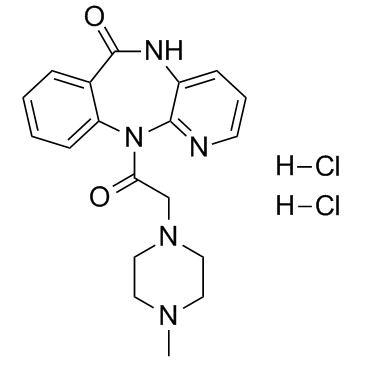Pirenzepine, Dihydrochloride

Pirenzepine, Dihydrochloride structure
|
Common Name | Pirenzepine, Dihydrochloride | ||
|---|---|---|---|---|
| CAS Number | 29868-97-1 | Molecular Weight | 424.324 | |
| Density | N/A | Boiling Point | 541.7ºC at 760 mmHg | |
| Molecular Formula | C19H23Cl2N5O2 | Melting Point | 248-250°C | |
| MSDS | USA | Flash Point | 281.4ºC | |
|
The novel protein kinase C epsilon isoform modulates acetylcholine release in the rat neuromuscular junction.
Mol. Brain 8 , 80, (2015) Various protein kinase C (PKC) isoforms contribute to the phosphorylating activity that modulates neurotransmitter release. In previous studies we showed that nPKCε is confined in the presynaptic site of the neuromuscular junction and its presynaptic function... |
|
|
Fasting stimulates 2-AG biosynthesis in the small intestine: role of cholinergic pathways.
Am. J. Physiol. Regul. Integr. Comp. Physiol. 309 , R805-13, (2015) The endocannabinoids are lipid-derived signaling molecules that control feeding and energy balance by activating CB1-type cannabinoid receptors in the brain and peripheral tissues. Previous studies have shown that oral exposure to dietary fat stimulates endoc... |
|
|
Adenosine receptors and muscarinic receptors cooperate in acetylcholine release modulation in the neuromuscular synapse.
Eur. J. Neurosci. 42 , 1775-87, (2015) Adenosine receptors (ARs) are present in the motor terminals at the mouse neuromuscular junction. ARs and the presynaptic muscarinic acetylcholine receptors (mAChRs) share the functional control of the neuromuscular junction. We analysed their mutual interact... |
|
|
Endocannabinoids mediate bidirectional striatal spike-timing-dependent plasticity.
J. Physiol. 593 , 2833-49, (2015) Although learning can arise from few or even a single trial, synaptic plasticity is commonly assessed under prolonged activation. Here, we explored the existence of rapid responsiveness of synaptic plasticity at corticostriatal synapses in a major synaptic le... |
|
|
M1 and m2 muscarinic receptor subtypes regulate antidepressant-like effects of the rapidly acting antidepressant scopolamine.
J. Pharmacol. Exp. Ther. 351(2) , 448-56, (2014) Scopolamine produces rapid and significant symptom improvement in patients with depression, and most notably in patients who do not respond to current antidepressant treatments. Scopolamine is a nonselective muscarinic acetylcholine receptor antagonist, and i... |
|
|
Structural and functional neuroprotection in glaucoma: role of galantamine-mediated activation of muscarinic acetylcholine receptors.
Cell Death Dis. 1 , e27, (2011) Glaucoma is the leading cause of irreversible blindness worldwide. Loss of vision due to glaucoma is caused by the selective death of retinal ganglion cells (RGCs). Treatments for glaucoma, limited to drugs or surgery to lower intraocular pressure (IOP), are ... |
|
|
Involvement of insular muscarinic cholinergic receptors in morphine-induced conditioned place preference in rats.
Psychopharmacol. Ser. 231(21) , 4109-18, (2014) Drug addiction represents a pathological usurpation of neural processes involved in learning and memory. Retrieval of drug-related memories can result in drug craving and relapse. Recently, the insula was identified as part of the neuronal circuit responsible... |
|
|
Increased density of M1 receptors in the hippocampus of juvenile rats chronically deprived of NGF.
Brain Res. 815 , 185-191, (1999) Binding studies were used to assess the changes in affinity and/or number of M1 muscarinic receptors in hippocampi from juvenile rats chronically deprived of NGF. NGF deprivation was obtained by implanting into right ventricle at postnatal day 2 (P2) hybrydom... |
|
|
Functional acetylcholine muscarinic receptor subtypes in human brain microcirculation: identification and cellular localization.
J. Cereb. Blood Flow Metab. 19 , 794-802, (1999) Acetylcholine is an important regulator of local cerebral blood flow. There is, however, limited information available on the possible sites of action of this neurotransmitter on brain intraparenchymal microvessels. In this study, a combination of molecular a... |
|
|
Autoantibodies against muscarinic type 3 receptor in Sjögren's syndrome inhibit aquaporin 5 trafficking.
PLoS ONE 8(1) , e53113, (2013) Sjögren's syndrome (SjS) is a chronic autoimmune disease that mainly targets the salivary and lacrimal glands. It has been controversial whether anti-muscarinic type 3 receptor (α-M3R) autoantibodies in patients with SjS inhibit intracellular trafficking of a... |